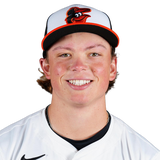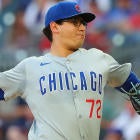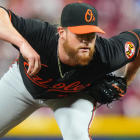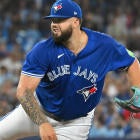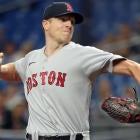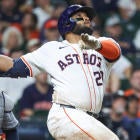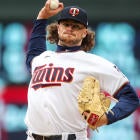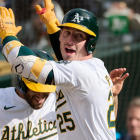
I want to make clear upfront that Jackson Holliday is the top minor-leaguer to stash.
I'd rather not include him in my Five on the Verge because the urgency is too high for too many other prospects who you've heard less about. It irks me that Jordan Beck and Tyler Black were never featured there prior to their promotion, and I'd rather not have the same happen for some other prospect just so I could tell you more about Holliday.
| ||||||||||
What more is there to say right now? The pain of his demotion is still raw, the completeness of his failure indisputable. His two weeks in the majors were about as ugly as it gets, which is forgivable seeing as he's a 20-year-old with basically one year of minor-league experience, but enough Fantasy Baseballers had enough invested in him that resentment is the only feeling to feel right now. Give him a couple weeks to dismantle Triple-A, and maybe new feelings will emerge.
He's still an amazing talent, and the Orioles could still use him. I imagine that whenever he returns -- which will likely be in short order -- he'll have a better idea what's in store for him and come closer to meeting expectations.
But for now, there's nothing more to analyze or explain. All that's needed is clarification that in leagues where any minor-leaguer is worth stashing, Holliday is worth stashing.
Let's talk about some others who are.
FIVE ON THE VERGE
(These are the prospects most worth stashing in redraft leagues.)
Paul Skenes, SP, Pirates
2023 minors: 6 2/3 IP, 5 H, 4 ER, 2 BB, 10 K
2024 minors: 0.39 ERA, 0.87 WHIP, 23 IP, 6 BB, 41 K
Skenes threw a total of 19 pitches in spring training and no more than 3 1/3 innings in any of his first four starts at Triple-A. With that, it seemed clear to me that the Pirates were delaying his buildup by a month so that he would be available to them a month later into the season -- which, by the way, is what all organizations should do with pitchers who have obvious innings limits. All this time, then, I've been saying that we'll know Skenes is on his way when the Pirates have him go four, then five, then six innings. At this point last week, he had just gone four innings for the first time, so presumably five was next. But instead, he skipped right over five and hurled six shutout innings Tuesday, delivering 75 pitches total.
It was dominant in the same way every Skenes start has been. He topped 100 mph on 13 of his pitches, bringing his season count to 89 -- or twice as many as any other minor-league pitcher at that point, according to MLB.com. The No. 1 pick in the 2023 draft is equipped to set a new standard for velocity among starting pitchers, and it could begin within a week or two.
I'll go out on a limb and say that Skenes makes one, maybe two, more Triple-A starts before being called up. He's already rostered in 87 percent of CBS Sports leagues, but if you're in one of the few where he isn't, now is the time to pounce.
Junior Caminero, 3B, Rays
2023 minors: .324 BA (460 AB), 31 HR, .976 OPS, 42 BB, 100 K
2024 minors: .333 BA (54 AB), 6 HR, 1.149 OPS, 5 BB, 13 K
Caminero had been a fixture atop my Five on the Verge, and the fact that Skenes has surpassed him shouldn't dampen your enthusiasm. In fact, Caminero has seemingly gone into beast mode the past couple days, initiating the sort of power binge that could precipitate his return to majors. He hit two home runs in the second game of a doubleheader Wednesday, giving four homers in his past three games.
JUNIOR CAMINERO HAS DONE IT AGAIN
— Durham Bulls (@DurhamBulls) May 2, 2024
He homers for the 2nd time in game 2 tonight, giving him a pair of 2-homer games over his last 3 contests going back to Sunday! pic.twitter.com/dlh6WbisRD
Only five major-leaguers have an average exit velocity higher than his 95.2 mph, and contact quality has always been his defining feature, validating the numbers he's put up in the minors the past two years. Of course, it's still the case that the Rays don't really have a place to play him, particularly now that Jonathan Aranda (fractured finger) is on a rehab assignment, but they've never been lacking for creativity. Caminero may force the issue sooner than later.
Kyle Manzardo, 1B, Guardians
2023 minors: .236 BA (351 AB), 17 HR, .801 OPS, 55 BB, 80 K
2024 minors: .323 BA (96 AB), 8 HR, 1.067 OPS, 15 BB, 19 K
How much longer will the first-place Guardians to stick with their revolving door of nobodies at DH? It's mostly been Estevan Florial, who's now hitting .212 with the sort of strikeout rate that suggests it's not going to get any better (but we already knew that). Meanwhile, the player widely presumed to be their DH-in-waiting from the day they acquired him in the Aaron Civale deal last July has been taking a wrecking ball to Triple-A, batting .429 (18 for 42) with seven homers in his past 11 games.
There's simply no justification for this arrangement to continue much longer. The Guardians need the help now, and Manzardo appears to be a finished product. He's walking nearly as much as he's striking out, and his zone-contact rate is an absurd 91.4 percent, which is to say that when he gets a pitch to hit, he doesn't miss. First base isn't the position of the greatest need in Fantasy, but Manzardo's bat could be an impactful one there, particularly for people who lost Triston Casas.
Max Meyer, SP, Marlins
2024 minors: 7 IP, 8 H, 6 ER, 1 BB, 7 K
2024 majors: 2.12 ERA, 0.82 WHIP, 17 IP, 3 BB, 14 K
So we now know that Roddery Munoz was the pitcher called up to replace Jesus Luzardo (elbow tightness), and judging by the way he performed Wednesday against the Rockies, that arrangement will continue for now. But it's notable that the Marlins have already departed from their stated plan of having Meyer throw three innings once a week. His latest start Saturday lasted four innings, and he wasn't even pitching well in it. But isn't the poor pitching itself a problem? Well, according to Christina De Nicola of MLB.com, it's because the Marlins have asked him to limit his slider use for the sake of refining his other pitches:
Max Meyer's second start at Triple-A Jacksonville yesterday:
— Christina De Nicola (@CDeNicola13) April 28, 2024
4 IP, 6 H, 4 ER, 2 K, 2 HR
More important:
45.5% four-seamer
32.7% changeup
20% slider
Before being optioned, he had an MLB-high 49% slider usage (among starters). #Marlins want him working on his other pitches.
The bigger takeaway is that they're letting him go longer than they originally suggested, keeping him stretched out for a possible return to the big-league rotation should the need arise. And now that Muñoz is up, I don't know where else they would turn other than Meyer. It could be that Luzardo doesn't miss much time or that Braxton Garrett makes it back from his shoulder injury before Meyer is needed. But with a rotation as young as the Marlins', the next injury isn't far away.
Christian Scott, SP, Mets
2023 minors: 2.57 ERA, 0.86 WHIP, 87 2/3 IP, 12 BB, 107 K
2024 minors: 3.20 ERA, 0.71 WHIP, 25 1/3 IP, 6 BB, 36 K
Scott is coming off his worst start of the season, having struck out only two over 4 2/3 innings. Of course, he still allowed just one hit. Unfortunately, Jose Butto solidified his claim to a rotation spot with his six strong innings against the Cubs Wednesday, and Tylor Megill and David Peterson are now out on rehab assignments, with Kodai Senga inching closer to a return as well. It may be that what once seemed like a golden opportunity for Scott is about to pass him by.
"I think Christian has done everything we could have hoped and expected," president of baseball operations David Stearns said earlier this week. "I think there's this balancing act when you call up a prospect of when is the prospect ready and then when is there the major-league need. Often, those need to overlap and intersect, and for some guys down there, we're probably just waiting for that intersection to occur."
If Megill, Peterson and Senga all stay on schedule, Scott may get pushed out of my Five on the Verge before he gets the call. But seeing as he'll be turning 25 this summer, you have to figure the Mets will find a way to work him in at some point even as their rotation fills up.
Update: The Mets have called up Scott, and he'll reportedly make his debut Saturday against the Rays. Because there's no obvious opening for him, he'll have little margin for error, particularly with Megill and Peterson working their way back. I presume the Mets will find a way to keep Scott around if he dominates, though. For now, I'm slotting him 66th at starting pitcher.
FIVE ON THE PERIPHERY
(Here are some other prospects doing something of note.)
Coby Mayo, 3B, Orioles
2023 minors: .290 BA (504 AB), 29 HR, .973 OPS, 93 BB, 148 K
2024 minors: .333 BA (120 AB), 10 HR, 1.067 OPS, 12 BB, 37 K
Is there a chance the Orioles turn to Mayo before they bring back Jackson Holliday? I would have said no a couple weeks ago, when his strikeout rate was out of control, but he's brought it back under control with a 21.1 percent rate over his past 17 games. And of course, the power never went anywhere. He's now homered in three straight and is impacting the ball like an elite slugger. Just look at this screamer from Wednesday:
Coby Mayo (@Orioles) goes deep for the third straight game 🚀
— MLB Pipeline (@MLBPipeline) May 2, 2024
MLB's No. 27 prospect ups his @NorfolkTides OPS to 1.067 across 29 games this year. pic.twitter.com/S3p3q75QjS
Only 12 major-leaguers have a max exit velocity higher than Mayo's 114.9 mph. He doesn't play the same position as Holliday, of course, but with Jordan Westburg's ability to flip between second and third base, an opening certainly exists. If Mayo isn't one of the top five prospects to stash, he's one of the top 10.
Jacob Wilson, SS, Athletics
2023 minors: .333 BA (99 AB), 1 HR, 4 SB, .866 OPS, 6 BB, 11 K
2024 minors: .414 BA (70 AB), 3 HR, 2 SB, 1.103 OPS, 1 BB, 9 K
Former Pirates shortstop Jack Wilson was known much more for his glove than his bat, and his son Jacob wasn't thought to pack enough wallop to justify the the sixth overall pick that the Athletics used on him last year. But what the 22-year-old lacks in power he makes up for with preternatural contact skills. Even with an aggressive promotion to Double-A or what's his first full professional season, he simply doesn't miss. It's an odd profile rarely found in the modern game, which is why I'm inclined to bet against Wilson becoming a big Fantasy asset, but the more success he has, the more I'm willing to keep an open mind. It's not like the power has been totally lacking, particularly when you count up his doubles.
Owen Murphy, SP, Braves
2023 minors: 4.72 ERA, 1.28 WHIP, 89 2/3 IP, 32 BB, 113 K
2024 minors: 1.52 ERA, 0.74 WHIP, 29 2/3 IP, 10 BB, 41 K
The Braves used their first-round pick in 2022 on Murphy, and his performance so far at High-A Rome is demonstrating why. The only thing more impressive than the number of strikeouts is the lack of hits. Opponents are batting just .119 against him. Most interesting of all is that he's doing it without a conventional power arsenal. His fastball sits in the low 90s, but he throws it from a lower arm slot that makes for an optimal vertical approach angle. He also has two plus breaking balls featuring plenty of spin. It may just be that his arsenal is too advanced for the level and he's in for a rude awakening with a move up to Double-A, but the Braves know how to develop pitchers and seem to like what they have in this one.
George Klassen, SP, Phillies
2024 minors: 0.00 ERA, 0.57 WHIP, 21 IP, 5 BB, 32 K
A couple weeks ago, I wrote about the Mets' Jonah Tong, who's getting a surprising amount of hype for a 20-something who's blowing away hitters at Low-A. Another such pitcher is Klassen, who has yet to allow an earned run in his 21 innings of work. What's funny is he was kind of a disaster in college, where he worked mostly in relief, but the Phillies have him throwing strikes at a much higher rate, allowing his triple-digit fastball to play up. The real test will be after he moves up a couple levels, but his stuff is so nasty that it's fair to wonder if the Phillies got a steal with their sixth-round pick last year.
Matt Wilkinson, SP, Guardians
2023 minors: 1 IP, 0 H, 0 ER, 0 BB, 3 K
2024 minors: 0.35 ERA, 0.66 WHIP, 25 2/3 IP, 9 BB, 46 K
Wilkinson is more of a curiosity than a prospect at this point but well worth mentioning for the kind of start he's off to at Low-A Lynchburg, piling up 46 strikeouts while allowing just eight hits in his 25 2/3 innings. The show-stopper came two turns ago, when he struck out 15 over six no-hit innings. So why do I say he's a curiosity? Well, he barely reaches 90 mph with his fastball, but as Baseball America writes, it plays up due to his low release and incredible reach (6-foot-6 from a 6-foot-1 frame). Whether more advanced hitters will see through the gimmick is to be determined, but Joe Ryan has taught us that the secondary characteristics on a fastball (i.e., shape) can matter more than the primary ones (i.e, velocity).








